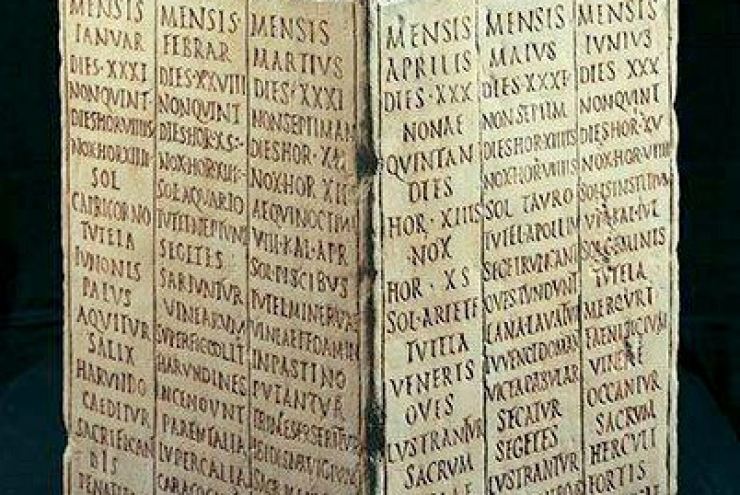
The Sikels undertook the escape for safety, finding the hostility of many other tribes, especially those ones from oscan stock (the heirs of the pit-tombs Culture), arriving then in the territory of their ‘’cousins’’ Enotrians, who gave them a welcome, at least in the first time. There, in present-day Calabria, the Sikels became numerous and very powerful, to the point that one of their king, whose name was Italus/Italo, name that means ‘’Young Bull’’, took possession of the whole Enotria, but causing after his death the unavoiding fall into hatred of his people among the Enotrians, to the point that they had to flee back to Sicily. That was the year 1270 BC. and the Sikels, ‘’a vast army’’, as Thucydides specified, conquered the entire eastern sector of the island, giving life to Sikelia, that means the ‘’Land of the Sikels’’; devastating and repelling with a long and bloody war the Sikans, that Paleo-European group (therefore always Indo-European), those who had settled on the island around the second half of the third millennium BC (the well known Castelluccio Culture), arrived from Italy (and not from Iberia) as well due to the arrival of the Ausonians in the peninsula[5]. Shortly afterwards the Elymes arrived in Sicily, always of Proto-Illyrian lineage, because, like the Morgetians, they were the result of a fragmentation of the Enotrian group, among which other ethnic elements converged by synecism, such as a small part of the Sikans and a larger part of Hellenes.
Dionysius of Halicarnassus and Diodorus Siculus, both lived during the first century. BC, as already mentioned, diligently and fortunately (for us) reported large parts (lectiones) of the now lost texts of these much older Sicilian historians (better said Sikeliotai, i.e. the Hellenes that settled in Sicily), who, being also in direct contact with these older inhabitans, could certainly dissert much more about them; referring again to Antiochus and Philistus of Syracuse, who lived respectively in the fifth and fourth centuries. BC, or Hellanicus of Mytilene, who lived in the fifth century. BC, and Timaeus of Tauromenium (now Taormina, in North-East of Sicily), who lived in the third century. B.C. Antiochus claimed the Iberian origin of the Sikans, the Trojan and Greek origin of the Elymes and the peninsular and Enotrian origin of the Sikels; Hellanicus claimed the peninsular and Enotrian origin of the Elymes, as the peninsular and Ausonian origin of the Sikels; Philistus, very close to the Sikels’ culture, being a general under Dionysius I and having in the army a large group of Sikels (the foundation of colonies in central Italy, such as Ancona[6], is a proof of this), supported the Iberian origin of the Sikans and the peninsular origin of the Sikels, but wrongly considered Ligurians, well knowing instead that those ‘’Liburnians’’, very close relatives of the Sikels, were considered Ligurians by the oldest copyists, making then such a mistake, and thus the only one who had understood the truth very well, he was considered instead the worst. And finally, Timaeus, who very reported many errors instead, but accusing all of the above mentioned of ignorance. He affirmed that the Sikans were indigenous, as ‘’sprung out of the earth’’, and that the Sikels were always of peninsular origin. Tuchydides also maintained that the Sikels had been driven away by the Oscan population of the Opicians (Opici in Latin, Opikoi in ancient Greek), who lived in Campania, and that the migration had taken place in the 11th century. B.C.; while Antiochus claimed that the Sikels had been driven away by the Enotrians, but he did not know how to place this migration precisely; then Philistus, that affirmed that in the eightieth year before the destruction of Troy, therefore in 1264 BC, the migration of the Sikels to Sicily took place due to the Enotrians; and then Ellanicus, who placed this migration with great precision in the twenty-sixth year of priesthood of Alkion in Argos (Greece), therefore in 1270 BC, but with that different version consisting in the expulsion of the Elymes always due to the hostility of the Enotrians, who would have arrived in the westernmost part of the island, and just five years later the Sikels fled from the Iapigians (Daunians and Peuketians) who inhabited the North of Puglia, considering then the Sikels if not the Ausonians. As far as the Sikans, Virgil in fact recalls in the Aeneid the veteres ‘’old’’ Sikans and the bloody battle against the Ausonians, who put an end to the Golden Age[7].

The Sikans, once arrived in Sicily in the middle bronze age, gave birth to the facies of Castelluccio and Thapsos from 2200 to 1270 BC (both Cultures characterized the middle Bronze Age of Sicily, expecially the eastern coast).I can afford to give an end to this short (and pleasant, I hope) issue by saying that the Sikels were the Proto-Illyrians who occupied the eastern part of the island, incorporating some Ausonian elements (already entered into the cultural orbit of the Proto-Villanovian, between Ausonius I and II of the Aeolian archipelago), flanking the Enotrian tribe of the Morgetians from the beginning of the 13th century. BC, and through other subsequent migration phenomena (up to the 11th century BC), and above all who called themselves with such a name, Sikuli, already starting from their first Balkan settlement (otherwise, Pliny the Elder would never have spoken of Balkan Sikels in his Naturalis Historia, still present there in his time[8]); that the Sikans were the Indo-Europeans A of sub-Carpathian origin who migrated from Italy to Sicily at the end of the third millennium BC; that the Morgetians were a fractionation of the Enotrian nation, therefore always Proto-Illyrians, and that once they reached eastern Sicily they kept a certain distance from the Sikels, even if the ‘’feathered’’ pottery was found in the vestiges of their most famous foundation, namely Morgantina; that the Elymes were also Proto-Illyrians, because they detached from the Enotrians, welcoming over time other ethnic elements and in minimal quantities, so little to never distort their language, and that they occupied the western side of Sicily shortly after the arrival of the Sikels; and finally the Ausonians, always Proto-Illyrians, were really driven out from the North-East by the arrival of the Illyrians Iapigians (Daunians and Peuketians), migrating in part towards the South and thus reaching the Aeolian Islands and then the coasts of northern Sicily. Therefore Sicily was first called Trinakria ‘’Trinacria’’ (i.e. ‘’Three Capes’’), then Sikania ‘’Land of Sikans’’ and then Sikelia, today said ‘’Sicily’’. The name of Italy comes from the name of the Sikelian king Italus/Italo, being first Ausonia and then after Enotria. Even the Adriatic Sea has a distinctly Sikelian-Illyrian origin in the name and so does the name of the person that derives from it, Adriano: both names have the common origin from the God Adranòs (in Sikelian language Hatranus), God of Heaven, of Light, of Thunderbolt and Fire, praised by the Sikels (i.e. the ancestral Indo-European Djēus Pәtēr), directly from the Sikelian root-word hat– ‘’fire/heat’’, of clear indo-european filiation, being the ancestral one aidh-.The Greeks born in Sicily called themselves Sikeliotai, i.e. ‘’Greeks of Sikelia’’, but they were not Sikels at all; just as the Greeks born in southern Italy, later called Magna Grecia (Latin)/Megale Hellas (ancient Greek, and both meaning ‘’Greater Greece’’), were called Italiotai, i.e. ‘’Greeks born in the land ruled by the Sikelian king Italo’’. But the denomination of ‘’Sicilians’’ where does it come from then? Simple, the suffixation in n reveals the mystery: they are all those who come from Sikelia, the island that was conquered by the great Sikels.
Alessandro Daudeferd Bonfanti
Note:
[1] Thucydides, Histories (otherwise The Peloponnesian War), book VI, 2, 4-5.
[2] Dionysius of Halicarnassus, The Roman Antiquites, book I, 22, 1-5.
[3] Diodorus Siculus, The Historical Libray, book V, 2-8.
[4] Pliny the Elder, Naturalis Historia, book III, 14, 112.
[5] And this is also confirmed by: Pausanias, Ἑλλάδος Περιήγησις (Description of Greece), book V, 25, 6; Strabo, Γεωγραφικά (Geography), book VI, 2, 4.
[6] Pliny the Elder, Naturalis Historia, book III, 13, 111: Numana a Siculis condita, ab issdem colonia Ancona.
[7] Virgil, Aeneid, book VIII, vv. 322-332.
[8] Pliny the Elder, Naturalis Historia, book III, 22, 141.
















